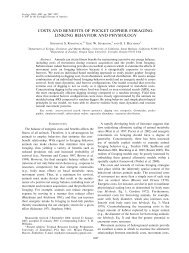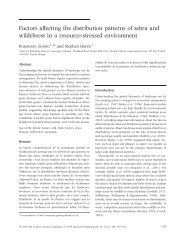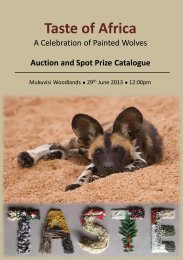The feeding ecology of the aardvark Orycteropus afer - ResearchGate
The feeding ecology of the aardvark Orycteropus afer - ResearchGate
The feeding ecology of the aardvark Orycteropus afer - ResearchGate
You also want an ePaper? Increase the reach of your titles
YUMPU automatically turns print PDFs into web optimized ePapers that Google loves.
146 W. A. TAYLOR ET AL.Table 7. Calorific values <strong>of</strong> six common prey species <strong>of</strong> <strong>aardvark</strong> at TdRCalorific value(MJ kg)Anoplolepis custodiens 20)300 (0)305)Anoplolepis steingroeveri 20)597 (0)663)Messor capensis 20)081 (0)436)Dorylus helvolus 21)793 (0)230)Hodotermes mossambicus 19)195 (0)244)Trinervitermes trinervoidesSoldiers 23)870 (0)579)Workers 18)743 (0)568)Alates 27)002 (1)462)Standard deviations in paren<strong>the</strong>ses.Calorific valuesTable 7 shows <strong>the</strong> calorific values <strong>of</strong> six <strong>of</strong> <strong>the</strong> common prey species. <strong>The</strong>re was nodifference between A. custodiens and A. steingroeveri (t"0)698, df."10, p"0)49),and no difference in <strong>the</strong> calorific value <strong>of</strong> A. custodiens between summer and winter(t"!0)071, df."17, p"0)944). <strong>The</strong>re was, however, a difference between <strong>the</strong>three T. trinervoides castes (ANOVA: F"132)1, df."2, p(0)0001).Prey valuesTable 8 shows <strong>the</strong> prey values <strong>of</strong> <strong>the</strong> major prey species and <strong>the</strong> values <strong>of</strong> associatedvariables for both winter and summer. T. trinervoides had <strong>the</strong> highest prey values in bothseasons. A. custodiens had <strong>the</strong> second lowest prey value in winter, while in summer itranked in <strong>the</strong> middle.<strong>The</strong> assumption that <strong>the</strong> parameters used in <strong>the</strong> calculation <strong>of</strong> prey values wereimportant was tested by a backwards stepwise regression (BSR) on <strong>the</strong> summer andwinter data. A threshold F value <strong>of</strong> 4)00 was used to determine which parameters wereremoved from <strong>the</strong> model.Utilisation <strong>of</strong> prey species in winter could be predicted from a linear combination <strong>of</strong><strong>the</strong> following independent variables: abundance (BSR: F"7)1, df."3, p"0.032), size(BSR: F"4)8, df."3, p"0)066) and mobility (BSR: F"19)6, df."3, p"0)003). Insummer, utilization could be predicted only by mobility (BSR: F"13)8, df."1,p"0)05).Discussion<strong>The</strong> diet <strong>of</strong> <strong>the</strong> <strong>aardvark</strong> varies considerably between different localities withinsou<strong>the</strong>rn Africa (Smi<strong>the</strong>rs, 1971; Smi<strong>the</strong>rs & Wilson, 1979; Melton & Daniels, 1986;Willis et al., 1992), yet all studies concur that <strong>the</strong> Formicidae predominate over <strong>the</strong>Isoptera.Species contributionsAnoplolepis spp. were by far <strong>the</strong> most common and important prey species in <strong>aardvark</strong>faeces at TdR. This is in agreement with <strong>the</strong> results <strong>of</strong> Willis et al. (1992) who found 14





